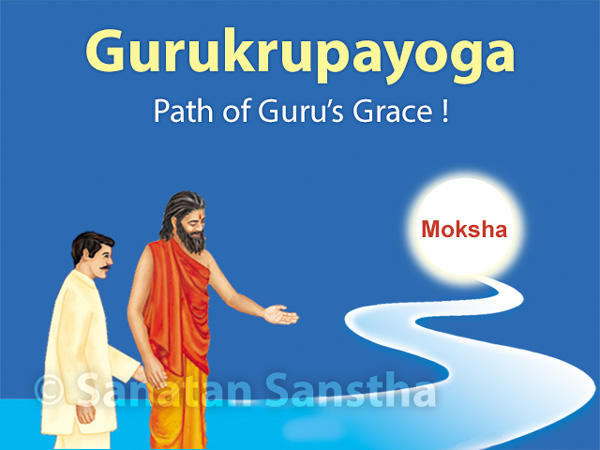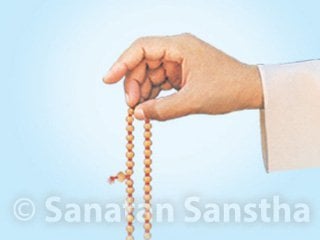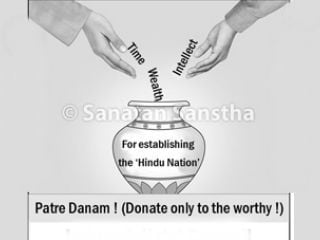A foreigner asked a saint, “Could you describe the uniqueness of India as briefly as possible?” The saint responded by saying “The Guru-disciple lineage”. Seekers who have practiced Spirituality through various paths for several years and not progressed beyond a particular spiritual level yearn to attain the Guru’s grace. On the other hand seekers who have made spiritual progress by the grace of the Guru get spiritual experiences to prove the absolute supremacy of this path.
1. Meaning
The word krupa has been derived from the root krup which means to be compassionate. Krupa means compassion, anugraha (initiation) or a prasad (blessing). Thus Gurukrupayoga is the path in which by means of the Guru’s grace (gurukrupa) the embodied soul is united with Shiv (God Principle).
2. Importance of the Path of Guru’s Grace
In this path a seeker learns how to acquire the Guru’s grace at the earliest, bypassing all other paths instead of wasting several years following various paths of spiritual practice. Consequently it is only natural that one makes rapid spiritual progress by following this path. With spiritual practice through any path other than the Path of Guru’s Grace one makes progress on an average at the rate of 0.25% per year. If one undertakes spiritual practice as advised by the Guru then one can make spiritual progress of up to 2-3% annually. If a disciple is able to acquire the grace of a Guru, then spiritual progress of even up to 5 to 8% per year may be possible. Actually the Paths of Action, Knowledge and Devotion are significant only till one is blessed by a Guru (guruprapti). Thereafter since the disciple undertakes only the spiritual practice advised by the Guru only the Path of Guru’s Grace (Gurukrupayoga) remains. Let us look at the table to get a better understanding.
| Importance % | Spiritual level of the seeker who can perform this spiritual practice | |
|---|---|---|
| 1. Namasankirtanyoga (Path of Chanting The Lord`s Name) | ||
| 1A. Chanting with effort (in the Vaikhari (Mode of speech of an average individual, totally devoid of Bliss) mode of speech) | 5 | 40 |
| 2. Path of Guru’s Grace (Gurukrupayoga) | ||
| 2A. priti (Spiritual love for others) | 30 | 50 |
| 2B. Remaining in the company of the Guru while chanting | 40 | 50 |
| 2C. Obedience | 60 | 60 |
| 2D. Service of the Absolute Truth (Guru) along with chanting | 70 | 60 |
| 2E. Sacrifice (offering one’s body, mind and wealth to the Guru totally) | 100 | 80 |
3. Importance of the Guru’s grace (gurukrupa)
One comprehends the nirgun (unmanifest) with intellect and the sagun (manifest) with priti (spiritual love). This intellect is a subtle form of the intellect acquired by studying the scriptures. This intellect destroys the anadi (one without a beginning) illusion. From the beginning of the state of the jivadasha (embodied soul) each one has the illusion (misconcept) that “I am distinct from Brahman”. By studying the scriptures one realizes by means of his intellect that “I am not distinct from Brahman”. However later he begins to feel, “If I am not different from Brahman then how is it that I do not experience it?” and thus another illusion develops. This illusion having an origin is described as the adi illusion. This adi illusion is destroyed solely by the grace of the Guru. This means that on account of the Guru’s grace the sagun prem (love of the manifest) and the sagun bhakti (devotion of the manifest) derived through satsang (holy company) transform his love, that is convert love into spiritual love which is devoid of expectation and thus the form of the manifest itself vanishes. As a result, the notions originating from relative knowledge that the manifest has a form and the unmanifest is formless are destroyed. When relative knowledge gets transformed into absolute knowledge the difference between the manifest and the unmanifest with regard to form, no longer persists. If relative knowledge were to be true then its awareness would not have been destroyed. This awareness of relative knowledge that is pratyay itself is the adi illusion. Once devotion of the manifest begins, sakshatkar (actual realization) that the manifest is really unmanifest Bliss occurs, the knowledge of the unmanifest that is thinking that the unmanifest is different from the manifest dissolves and one experiences that “I am Brahman” that is one experiences non-duality. Hence, saints term the unmanifest as the most subtle among vachyansha (spoken topics) and the manifest as the lakshyansha (ultimate target), that is The Lord. Since scholars have no experience of satsang, this concept is not acceptable to them. Rameshvar Bhaoo who was instrumental in immersing the holy verses of Saint Tukaram in water attained Absoluteness (Purnatva) with the grace of Saint Tukaram alone.
Reference : Sanatan Sanstha’s Holy Text on ‘Gurukrupayoga’


 Why do we chant Name of Kuladevi instead of Kuladev?
Why do we chant Name of Kuladevi instead of Kuladev? Remedies for mental illness arising in an emergency
Remedies for mental illness arising in an emergency how to improve mental strength to face a terrible situation such as a riot
how to improve mental strength to face a terrible situation such as a riot Guidance by His Holiness Bhagwantkumar Menrai on how to coordinate chanting the Name of God...
Guidance by His Holiness Bhagwantkumar Menrai on how to coordinate chanting the Name of God... Difference between donation and offering and their importance
Difference between donation and offering and their importance Do not feel scared by the increasing coronavirus outbreak all over and strengthen your inner-self...
Do not feel scared by the increasing coronavirus outbreak all over and strengthen your inner-self...